
Hot search terms: 360 Security Guard Office365 360 browser WPS Office iQiyi Huawei Cloud Market Tencent Cloud Store

Hot search terms: 360 Security Guard Office365 360 browser WPS Office iQiyi Huawei Cloud Market Tencent Cloud Store
For now, the common output interfaces on graphics cards are relatively abundant, as shown in the figure above. The ones we are familiar with include the following: VGA, DVI, HDMI and DP. These four output interfaces are the most common output interfaces on graphics cards. VGA is the output interface that everyone is familiar with. However, the three emerging output interfaces of DVI, HDMI and DP have several classifications for each category, and there are also versions. There are several types, so it is easy for beginners to be confused about these output interfaces. At the same time, depending on the grade of the graphics card, not all graphics cards have the above output interfaces. Below, we will explain the definitions, differences, and so on of these interfaces one by one, so that you can understand them clearly.
VGA interface - the most common and most seen graphics card output interface.
Speaking of the VGA interface, I believe many friends who are familiar with computers will be familiar with it, because this interface is the most important interface on computer monitors. Since the era of huge CRT monitors, the VGA interface has been used and has been used to this day. In addition, The VGA interface is also called the D-Sub interface, and it is the most widely used graphics card interface.
The VGA graphics card interface is a D-type interface with a total of 15 pins divided into three rows, five in each row. Moreover, the VGA interface has strong expansibility and can be easily converted to the DVI interface. The detailed VGA interface introduction of the graphics card is as follows:
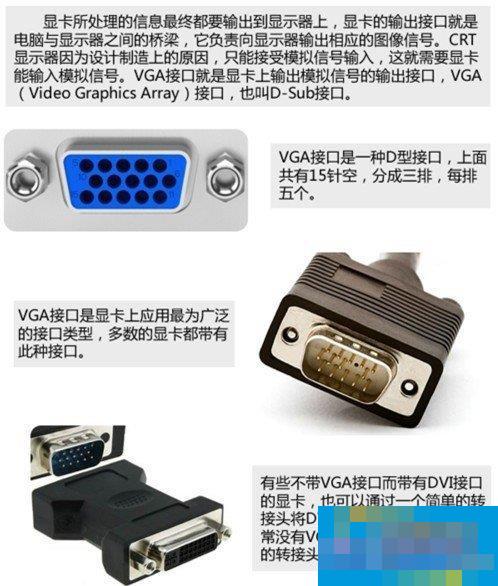
VGA output interface knowledge
For most friends, we only need to know that the VGA interface is the interface that prompts the monitor signal and is the interface connected to the monitor. However, as computer enthusiasts, we still need to have an in-depth understanding of the graphics card. Next, we will introduce the various VGA interfaces. The functions and functions of the pins are as shown below:
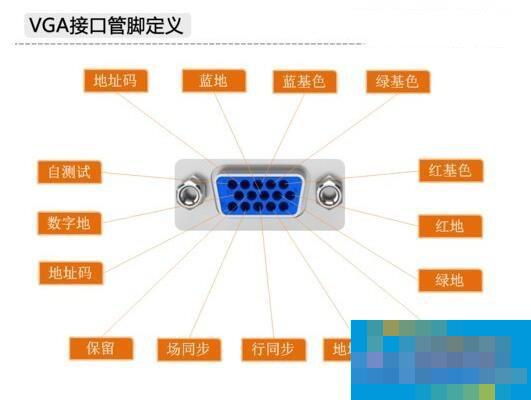
VGA pin interface function
VGA interface knowledge link
In the early days, most computers were connected to external display devices through the analog VGA interface. The digitally generated display image information inside the computer was converted into R, G, and B primary color signals by the digital/analog converter in the graphics card. Horizontal and field synchronization signals are transmitted to the display device through cables. For analog display devices, such as analog CRT displays, the signal is directly sent to the corresponding processing circuit to drive and control the picture tube to generate images; for digital display devices such as LCD and DLP, the display device needs to be equipped with the corresponding A/D (analog/ digital) converter that converts analog signals into digital signals. After the two conversions of D/A and A/D, some image details are inevitably lost. There is nothing wrong with the VGA interface being used in CRT monitors, but when used to connect display devices such as LCDs, the image loss during the conversion process will slightly degrade the display effect.
DVI interface--the interface that comes into being for LCD monitors
DVI (Digital Visual Interface), digital video interface. It was launched in 1999 by the DDWG (Digital Display Working Group) formed by Silicon Image, Intel, Compaq, IBM, HP, NEC, Fujitsu and other companies. Interface standards.
The Digital Display Working Group (DDWG for short) established at the Intel Developer Forum in September 1998 invented a technology for high-speed transmission of digital signals, namely: DVI digital video interface, which includes DVI-A, DVI -D and DVI-I three different types of interface forms. DVI-D only has digital interfaces, while DVI-I has digital and analog interfaces. Currently, DVI-D is the main application. At the same time, DVI-D and DVI-I have single link (Single Link) and dual channel (Dual Link). points, what we usually see are single-channel versions. The cost of dual-channel versions is very high, so only some professional equipment has them, and it is difficult for ordinary consumers to see them. DVI-A is an analog transmission standard that is often seen in large-screen professional CRTs. However, since it is not essentially different from VGA and its performance is not high, DVI-A has actually been abandoned.
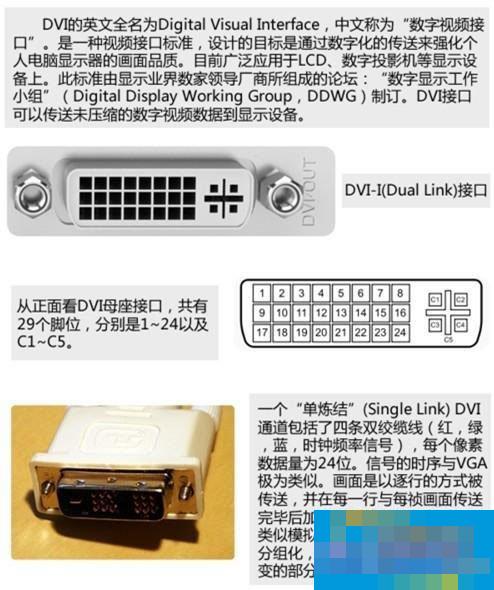
DVI interface knowledge diagram
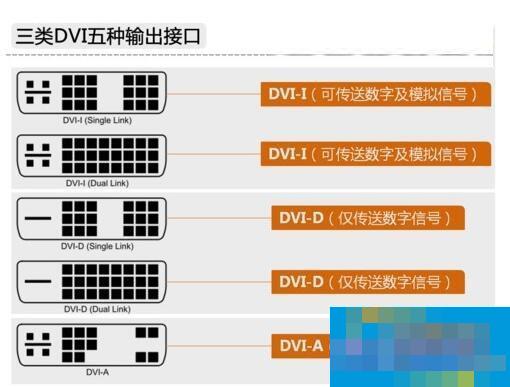
Three categories of DVI five output interfaces
We can often hear dealers describing DVI cables as having four specifications: 18+1 and 24+1 and 18+5 and 24+5. The 18-pin cable is a single-channel DVI, and the transmission rate is only half of that of the 24-pin cable, which is 165MHz. In terms of screen display, single-channel DVI supports exactly the same resolution as dual-channel, but the refresh rate is only about half of that of dual-channel, which will cause a decrease in display quality. If you use a large-screen LCD monitor, 24-pin dual-channel DVI is a must-have. As for the specifications of 18+5 and 24+5, both belong to DVI-I, and the extra 4 lines are used to be compatible with traditional VGA analog signals. This interface is mostly used on graphics cards and is rarely used on monitors.
HDMI high-definition interface--new revolution in high-definition output
HDMI High Definition Multimedia Interface (HDMI) is a digital video/audio interface technology. It is a dedicated digital interface suitable for image transmission. It can transmit audio and video signals at the same time, with a maximum data transmission speed of 5Gbps without the need for digital/analog or analog/digital conversion before signal transmission. HDMI can be paired with Wideband Digital Content Protection (HDCP) to prevent illegal copying.
HDMI high-definition is a very popular interface at present. Currently, mainstream graphics cards are generally equipped with HDMI high-definition interface, which has also become the output interface standard of current graphics cards. In addition, many motherboards also have HDMI high-definition interfaces. HDMI high-definition interface is currently widely used. It is popular among users because the display screen using HDMI high-definition interface is high-definition. Let’s take a look at the introduction of HDMI high-definition interface knowledge.
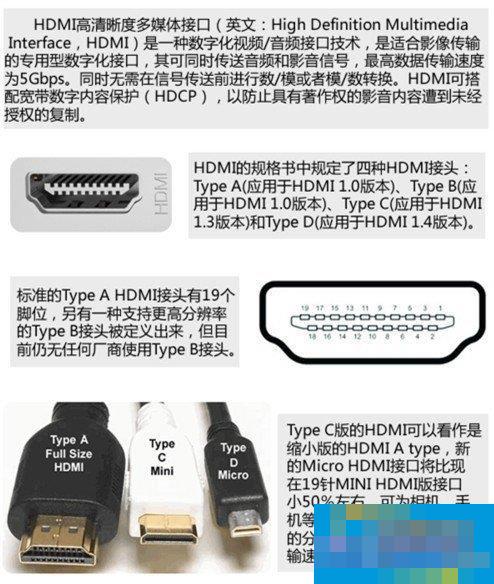
Detailed introduction to HDMI high-definition interface knowledge
In fact, there are multiple versions of the HDMI high-definition interface, which you may not know much about. Here is a comparison chart of different versions of the HDMI high-definition interface:
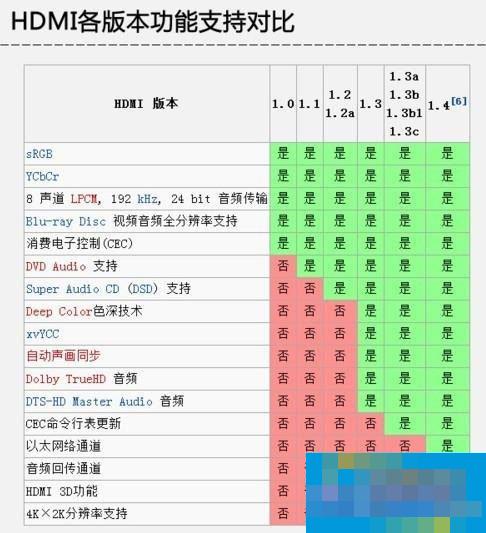
Function support comparison of various versions of HDMI high-definition interface
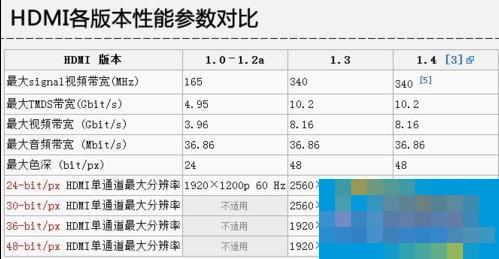
Comparison of parameters of various versions of HDMI high-definition interface
The HDMI interface can not only meet the resolution of 1080P, but also support advanced audio formats such as Dolby TrueHD and DTS-HD Master Audio. At the same time, HDMI supports EDID and DDC2B, so devices with HDMI have the characteristics of "plug and play", and the signal source There will be automatic "negotiation" between the display device and the display device to automatically select the most appropriate video/audio format. Compared with DVI, the HDMI interface is smaller. The cable length of DVI cannot exceed 8 meters, otherwise it will affect the picture quality, while HDMI can transmit up to 15 meters. Just one HDMI cable can replace up to 13 analog transmission lines, effectively solving the problem of messy and tangled connections behind home entertainment systems. Unfortunately, using the HDMI interface requires paying a certain technical agreement licensing fee.
DP interface - another high-definition interface that challenges HDMI
The DP interface is also a high-definition digital output interface standard. Can be connected to a computer monitor or set up a high-definition home theater, etc. Both DVI and HDMI transmit signals by converting them into TMDS minimizing transmission differential signals. However, the notebook field has long been dominated by LVDS (Low-Voltage Differential Signaling). The launch of the DisplayPort interface perfectly solves this problem. DisplayPort is now widely supported by the industry, mainly due to DisplayPort's two major advantages: first, DisplayPort's advantages in the protocol layer, DisplayPort uses MPA (Micro-Packet Architecture, Micro-Packet Architecture); second, notebooks, etc. Portable device issues. Using the DisplayPort interface greatly simplifies the wiring complexity.
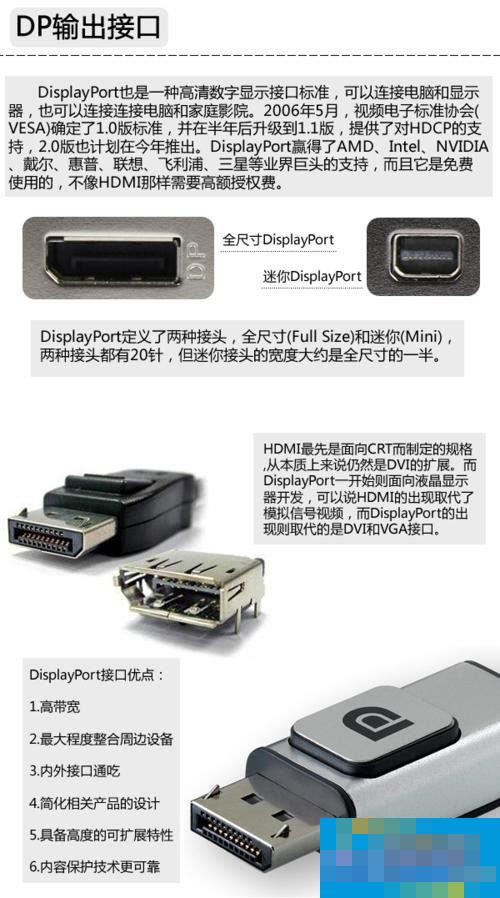
Detailed introduction to DP interface knowledge
Regarding the difference between DisplayPort and HDMI, we know that HDMI was first formulated for CRT specifications. Whether it is HDMI or its "twin brother" UDI (HDMI without the audio function), both inherit the core technology TMDS of DVI. Essentially It is still an extension of DVI. DVI, HDMI, and UDI video content are all transmitted in real-time and through dedicated lines, which ensures that no congestion will occur when video traffic is large. DisplayPort was developed for LCD monitors from the beginning, using the "Micro-Packet Architecture" transmission architecture. Video content is transmitted in packets, which is significantly different from video transmission technologies such as DVI and HDMI. In other words, the emergence of HDMI replaced analog signal video, while the emergence of DisplayPort replaced DVI and VGA interfaces.
The final editor of this article mainly introduces how to select and retain graphics card interfaces. The technological innovation of output interfaces for multiple needs also requires us to constantly try and explore. With the innovation of a series of display technologies such as high-definition, multi-screen and 3D display, the upgrading and upgrading of graphics card output interfaces are also following closely, constantly introducing new ones. It can be said that the introduction of DVI, HDMI and DP interfaces has greatly satisfied the quality requirements of netizens for display output effects. After netizens adopt these new high-bandwidth output interfaces, they can enjoy a more realistic, detailed and pleasant audio and video experience. These are all benefits brought by the technological update of the output interface.
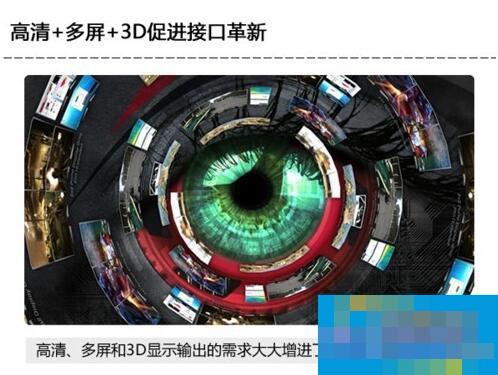
High-definition, multi-screen and 3D have greatly enhanced the innovation of output interfaces and also met the various needs of users.
Finally, we summarize the key points for selecting the display output interface of the graphics card:
1. Since the VGA interface is an analog signal, it inevitably causes the loss of some image details and is only suitable for monitors below 20 inches;
2. If the monitor uses a resolution of 1920*1200 or lower, DVI-I, DVI-D, HDMI, and DP interfaces are all available, and the screen size will have little impact;
3. If the display adopts ultra-high resolution, such as 2560*1600 or when building a multi-screen display output system, dual-channel DVI-D, HDMI, and DP can be used;
4. If you are using a 3D display, at a resolution of 1920*1080, DVI-D, HDMI and DP are not a big problem. If it is 2560*1600 or above, it is best to use HDMI and DP output interfaces.
The above is the entire content of the comprehensive knowledge collection of various interface types of graphics cards. If you are still confused about the various interfaces of the graphics card, you can refer to the above content to learn more, so that you will also have an understanding of the various interfaces of the graphics card! Not knowing anything.
 How to log in to 360 account with 360 speed browser - How to log in to 360 account with 360 speed browser
How to log in to 360 account with 360 speed browser - How to log in to 360 account with 360 speed browser
 How to change the skin of 360 Speed Browser - How to change the skin of 360 Speed Browser
How to change the skin of 360 Speed Browser - How to change the skin of 360 Speed Browser
 How to record the screen of 360 Speed Browser - How to record the screen of 360 Speed Browser
How to record the screen of 360 Speed Browser - How to record the screen of 360 Speed Browser
 How to shrink the obs window? -obs method to reduce window size
How to shrink the obs window? -obs method to reduce window size
 How to use beautification on obs? How to use beautification on obs
How to use beautification on obs? How to use beautification on obs
 CS1.6 pure version
CS1.6 pure version
 quick worker
quick worker
 iQiyi
iQiyi
 Sunflower remote control
Sunflower remote control
 NetEase MuMu emulator
NetEase MuMu emulator
 WPS Office
WPS Office
 Office 365
Office 365
 WPS Office 2023
WPS Office 2023
 WeGame
WeGame
 What to do if there is no sound after reinstalling the computer system - Driver Wizard Tutorial
What to do if there is no sound after reinstalling the computer system - Driver Wizard Tutorial
 How to practice typing with Kingsoft Typing Guide - How to practice typing with Kingsoft Typing Guide
How to practice typing with Kingsoft Typing Guide - How to practice typing with Kingsoft Typing Guide
 How to upgrade the bootcamp driver? How to upgrade the bootcamp driver
How to upgrade the bootcamp driver? How to upgrade the bootcamp driver
 How to change QQ music skin? -QQ music skin change method
How to change QQ music skin? -QQ music skin change method
 Driver President Download-How to solve the problem when downloading driver software is very slow
Driver President Download-How to solve the problem when downloading driver software is very slow